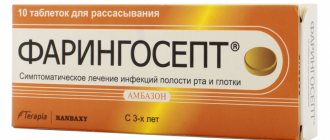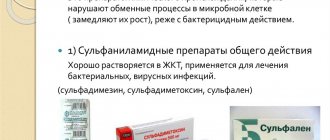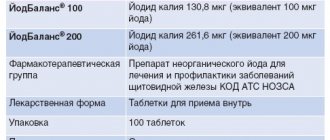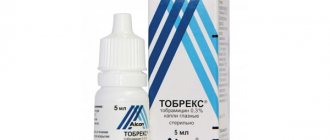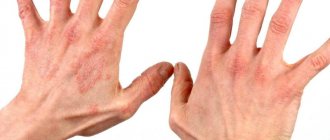pharmachologic effect
Antiallergic drug, selective blocker of peripheral histamine H1 receptors. Loratadine is a tricyclic compound with a pronounced antihistamine effect. Has a quick and long-lasting antiallergic effect.
Loratadine does not penetrate the BBB and has no effect on the central nervous system. Does not have a clinically significant anticholinergic or sedative effect, i.e. does not cause drowsiness and does not affect the speed of psychomotor reactions when used in recommended doses.
After oral administration of the drug Claritin, the onset of action is within 30 minutes. The antihistamine effect reaches its maximum 8-12 hours after the onset of action and lasts more than 24 hours.
Analogues of Claritin
When prescribing this antihistamine, a reasonable question arises as to what can replace it. Most often, inexpensive drugs containing the same active substance or drugs belonging to the same generation are offered as analogues. Analogues of Claritin are very popular: Loratadine, Lomilan, Claridol and Clarotadine. Also have a similar effect: Erius, Lotharen, Clallergin, Clarisens, Clarifarm, Clarifer, Clarfast, Loragexal, Alerpriv, Clargotil and Erolin.
Analogs
Claritin or Erius?
Both drugs are new generation antihistamines. Therefore, effectiveness and a minimum of side effects are inherent in each of these drugs. But it is believed that Erius has a wider spectrum of action.
Claritin or Loratadine?
The drugs contain the same active ingredient, but they still have differences.
Loratadine is a highly effective antiallergic drug of the second generation, but Claritin is already in the third generation. The therapeutic effect of taking it occurs faster, and the effect can last more than 24 hours. And he is also less likely to experience adverse reactions.
Claritin or Suprastin?
If Suprastin is compared with Claritin, then both antihistamines help well with allergies and have the same indications for use. They act quickly and effectively. Despite similar characteristics, the drugs differ. First of all, composition and generation. These medications have different active ingredients. Suprastin has chloropyramine, and Claritin has loratadine. Suprastin is a first generation antihistamine, and Claritin is a third generation. This means that Suprastin is not as selective in terms of blocking receptors and causes drowsiness. Claritin does not affect the central nervous system and provokes a sedative effect. But Suprastin can be used for infants, starting from the first month of life. Claritin is only allowed for children over two years of age. When taking the latter, the risk of adverse reactions is negligible. In addition, the use of Suprastin is undesirable if you are prone to bronchospasms, since sputum discharge is difficult.
Claritin has a prolonged effect, and one tablet per day is enough, in contrast to 2-3 doses of Suprastin.
It is believed that Claritin is stronger and better, but in some cases only Suprastin can help. For example, during acute attacks Suprastin in ampoules is preferable. Moreover, one of the indications for use is angioedema and anaphylactic reactions. In such conditions, Claritin will not help. Suprastin is effective for serum sickness and fever after vaccinations. It turns out that the drug in question acts more gently and is able to relieve mild and moderate allergic reactions.
Claritin or Zodak?
In general, Claritin and Zodak are not much different. Claritin is a third generation drug, unlike Zodak (second generation). For example, Zodak is often preferred when treating children, since it can be taken by children from one year old, which Claritin cannot boast of. But Zodak affects the central nervous system, so it should not be taken by those whose work involves driving, dangerous mechanisms, risk, increased attention and concentration. Claritin is more suitable here.
Another difference is the effect of Zodak on the cardiovascular system, unlike Claritin. Therefore, long-term use in this case is not recommended. As for long-term use, Claritin has a pleasant feature - it is not addictive. This means it can be used as a preventive measure for chronic allergies or their constant manifestations.
Also, Claritin has a prolonged action. It is efficient and fast. Zodak is no worse, but due to the fact that he belongs to the second generation, he has his own nuances. For example, it causes drowsiness. But it is cheaper.
Remember that when choosing a particular medicine, you must obtain the advice and approval of your doctor. Medicines should not be prescribed to yourself. This can be hazardous to your health!
Directions for use and doses
The drug is prescribed orally, regardless of food intake.
- Adults (including elderly patients) and adolescents over the age of 12 years are recommended to take Claritin at a dose of 10 mg (1 tablet or 2 teaspoons /10 ml/ syrup) 1 time / day.
- For children aged 2 to 12 years, the dose of Claritin is recommended to be prescribed depending on body weight: for body weight less than 30 kg - 5 mg (1/2 tablet or 1 teaspoon /5 ml/ syrup) 1 time / day,
- with a body weight of 30 kg or more - 10 mg (1 tablet or 2 teaspoons /10 ml/ syrup) 1 time / day.
Special instructions for the use of Claritin
Claritin does not have a clinically significant sedative effect when used in recommended doses (10 mg once daily). Claritin does not potentiate the effects of alcohol. At recommended doses, it does not affect the ability to drive vehicles or operate complex machinery. Claritin should be discontinued at least 48 hours before skin diagnostic allergy tests are performed to prevent false results. For patients with severe liver dysfunction, the initial dose should be reduced due to a possible decrease in the clearance of loratadine (an initial dose of 5 mg once daily or 10 mg every other day is recommended). Use in children. The effectiveness and safety of Claritin in children under 1 year of age has not been proven. It should be noted that the pharmacokinetics of Claritin in children aged 1–2 years when prescribed a single dose of 2.5 mg does not differ from the pharmacokinetics of adults and older children. Use during pregnancy and lactation. The safety of using the drug during pregnancy has not been established, therefore Claritin should be used only if the benefits of its use for the mother outweigh the potential risk to the fetus. Since loratadine is excreted in breast milk, a choice must be made between taking the drug and breastfeeding.
Analogs
Possible analogues of Claritin:
- Erius is a long-acting antihistamine aimed at eliminating or alleviating sneezing, nasal congestion, nasal mucus, itching of the nose, itching of the palate, itching and redness of the eyes, watery eyes;
- Ketotifen - effectively prevents attacks of bronchial asthma and other manifestations of immediate allergic reactions;
- Loratadine is indicated for the symptomatic treatment of allergic rhinitis and chronic idiopathic urticaria in adults and children over 2 years of age weighing more than 30 kg;
- Desloratadine - the drug copes well with seasonal and year-round allergic rhinitis, chronic idiopathic urticaria;
- Diazolin is most often prescribed for combination therapy of itchy dermatoses and bronchial asthma.
Release forms and composition
Claritin is available in the following forms:
- pills;
- syrup in children's dosage.
The composition of both drugs is similar, the comparative difference lies only in the dosage of the main active ingredient - Loratadine .
Additional substances:
- lactose monohydrate;
- corn starch;
- magnesium stearate.
Pills
allergy
tablets On one of the surfaces of the allergy tablet there is a depressed stripe, and on the other there is a branded bulb icon with the number 10.
Claritin can be purchased at the pharmacy in 1, 2 or 3 blisters in a cardboard box. Accordingly, the number of tablets can be 7, 10 and 30 pieces per package.
Syrup
In the form of Claritin syrup, 60 and 120 ml are produced in individual dark glass bottles.
The white or slightly yellowish solution is absolutely homogeneous.
The drug in this form does not have sediment or inclusions.
The dark glass bottle is placed in a branded cardboard package marked “anti-allergy product for children.”
Contraindications
- Age up to 2 years (for syrup), because no experimental trials have been conducted on the use of the allergy drug Claritin in children under 2 years of age
- Age up to 3 years (for tablets);
- Lactation period (breastfeeding);
- Rare hereditary diseases (impaired galactose tolerance, lapp lactase deficiency or glucose-galactose malabsorption) - due to the presence of lactose included in the tablets;
- For diseases associated with sucrase/isomaltase deficiency, fructose intolerance, glucose-galactose malabsorption - due to the presence of sucrose included in the syrup;
- Hypersensitivity to the components of the drug.
Indications for use
Claritin for allergies has the following indications for use:
- Inflammation of the nasal mucosa (allergic year-round and seasonal rhinitis).
- Inflammation of the mucous membrane of the eyes due to exposure to an allergen.
- Skin allergic manifestations (dermatitis, chronic urticaria, eczema).
- Phlebotoderma (allergic responses to insect bites).
- Atopic dermatitis and asthma.
Being a prodrug - an active metabolite - Claritin eliminates the painful symptoms of allergies - itching, burning and redness.
When ingested, the product relieves swelling of the mucous membranes caused by the allergen and helps reduce inflammation.
The prescription of Claritin for skin allergy symptoms is justified by its pronounced effect on target cells, which reduces skin irritation.
Use during pregnancy and lactation
There have been no clinical studies of the drug Claritin for allergies in pregnant women.
In this regard, if it is necessary to prescribe antihistamines, it is necessary to assess the possible risk to the fetus.
Loratadine is excreted in breast milk , so during lactation the issue of stopping breastfeeding for the entire period of treatment for allergy symptoms is discussed with the attending physician.
After treatment has ended, breastfeeding should not be resumed for 48 hours after taking the last dose of the medicine.
Side effects
In clinical studies in adults, adverse events observed more frequently than with pacifier use occurred in 2% of patients taking Claritin.
The following effects were noted:
- Increased nervous excitability;
- Fast fatiguability;
- Headache and dizziness;
- Sleep disturbance;
- Increased appetite;
- Dry mouth;
- Nausea, vomiting and pain in the epigastric region;
- Bitterness in the mouth;
- Pain in the right hypochondrium;
- Increased heart rate;
- Hair loss.
Side effects of Claritin in children:
- A headache may occur;
- There is drowsiness;
- Increased appetite;
- The most unpleasant thing is insomnia;
- Rarely - dizziness, fatigue, feeling of dry mouth;
- Stomach and intestinal disorders, skin rashes, limb cramps and increased heart rate.
Claritin overdose, symptoms and treatment
In case of overdose, drowsiness, tachycardia and headache may occur. With a single dose of 160 mg, no side effects were noted (including ECG changes). In case of overdose, symptomatic and supportive treatment is recommended. Standard measures are recommended to remove unabsorbed drug from the stomach: gastric lavage, taking activated charcoal. Loratadine is not eliminated by hemodialysis. After emergency treatment, the patient should remain under medical supervision.

